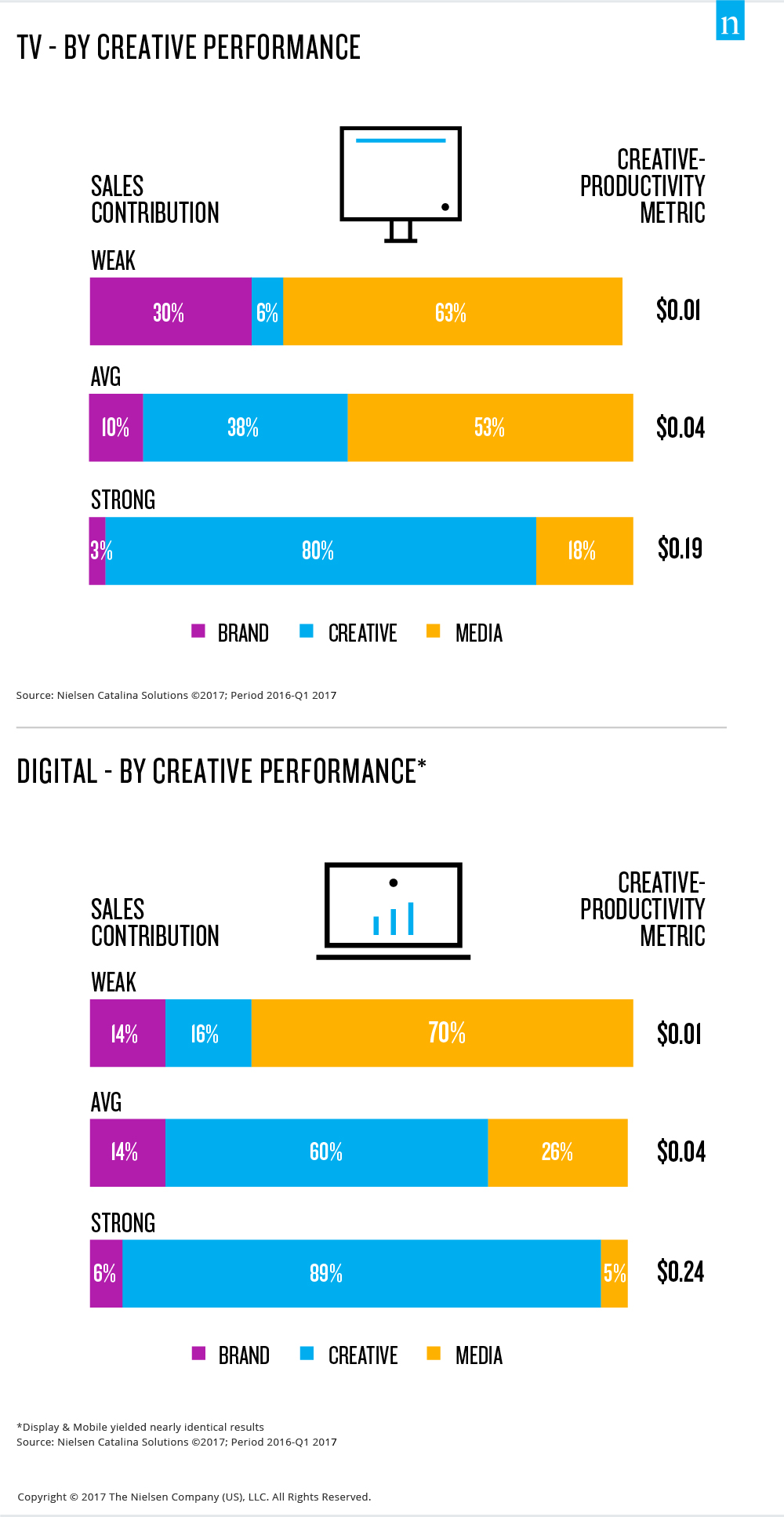 先日のある朝、ニールセンについて 、優れた広告とは何かについて、オフィスで即席の議論が起こった。私たちは、最近のお気に入りの広告についていくつか話し合ったが、想像できるように、ニールセンについて 、どれがベストかという提案の幅は広かった。ショートフォームとロングフォーム。面白いものと感傷的なもの。製品重視とブランド重視。理性的なものと感情的なもの。長さも目的もさまざまだったが、ひとつはっきりしていたのは、それらは「必見」の広告であり、番組の合間のフィラーではなく、ニールセンについて 、共有し、何度も繰り返し見たくなる素晴らしいクリエイティブだったということだ。
先日のある朝、ニールセンについて 、優れた広告とは何かについて、オフィスで即席の議論が起こった。私たちは、最近のお気に入りの広告についていくつか話し合ったが、想像できるように、ニールセンについて 、どれがベストかという提案の幅は広かった。ショートフォームとロングフォーム。面白いものと感傷的なもの。製品重視とブランド重視。理性的なものと感情的なもの。長さも目的もさまざまだったが、ひとつはっきりしていたのは、それらは「必見」の広告であり、番組の合間のフィラーではなく、ニールセンについて 、共有し、何度も繰り返し見たくなる素晴らしいクリエイティブだったということだ。
ニールセン・カタリナ・ソリューションズ(NCS)とニールセンの新しい共同リサーチ・プロジェクトの結果を見て、私は優れたクリエイティブの重要性を再認識した。クリエイティブは王様である!クリエイティブは王様だ!クリエイティブは、私たちが何に関心を持ち、何を共有し、ニールセンについて 、議論し、記憶し、購入するのかを後押しするものだ。クリエイティブは、それがいつ、どこで、どのように展開されるかにかかわらず、大きな力を持っている。ニールセンについて マッキントッシュ・コンピュータを紹介した1984年のアップルの広告は、今でも史上最も話題になった広告のひとつである。
この調査では、広告効果に貢献する5つの主要なドライバー、すなわちクリエイティブ、リーチ、ターゲティング、リセンシー、コンテクストの売上貢献度を定量化しようとした。調査結果は、これらのドライバー間の相対的なバランスが時代とともにどのように変化してきたか、またテレビとデジタルのチャンネル間でどのように作用するかを示している。私にとって最も興味深かったのは、クリエイティブの質が、他のすべての要素を合わせたのと同じくらい、ブランドの市場での成功に貢献するという結果が示されたことだ。さらに、この調査では、クリエイティブが強力な場合、それが市場内成功の圧倒的な原動力となることが判明した。逆に、クリエイティブが弱い場合、テレビとデジタル広告全体において売上は伸び悩み、他のメディア要因が主な原動力となる。
つまり、優れたクリエイティブは、伝統的なテレビとデジタルの両プラットフォームを問わず、広告キャンペーンを成功に導く唯一で最も重要な要素であり続けている。新しいツールやテクニックは、リーチを強化し、拡大し、ターゲットを絞り込むことができ、広告主が消費者を見つけるための新しいフォーマットやデスティネーションが日々生まれているようだ。しかし、真に成功する広告キャンペーンを推進するとなると、優れたクリエイティブがもたらす力にはかなわない。

This, of course, raises several questions: What is great creative? How do marketers know if their creative is “great?” And how do they achieve great success with it?
In the past, marketers have relied on qualitative and/or quantitative self-report copy testing to evaluate creative. Essentially, they made decisions based on biased consumer responses often aided by their professional eyes and instincts. Essentially, they went with what they thought would work. While this may have kept very poor advertising off the air, it left some potentially great work on the drawing board. And if they had a piece of creative they needed to cut down/compress, they might have relied on personal judgment.
This is where consumer neuroscience increasingly plays an important role for marketers. That’s because the current suite of tools combining EEG, eye tracking, facial coding and biometrics, along with self-report surveys, offer a unique opportunity. Not only can these tools measure and evaluate on a macro level (i.e., what works and what doesn’t), they go even deeper, providing moment-by-moment insight that can pinpoint where a spot(s) needs to be adjusted. The results enable a collaborative approach between marketers, creative agencies and researchers to help go from early stage to primetime success—avoiding the cutting-room floor that has claimed too many could-have-been-great ads. This is because consumer neuroscience measures what traditional research methods cannot. Methods like surveys can only tap into our conscious responses, which we know are often heavily biased and are only one, arguably smaller, component of how we consume media. Studies have shown that the majority of our decision-making happens non-consciously, so much of what drives everyday decisions—including what we’ll purchase, watch and talk about—requires tools that can measure these responses.
Several years ago, we developed a model designed to understand the explosion in content platforms and the types of creative that can be optimized for each. Our Brand Immersion Model became a framework for defining the relationship between the immersive platform of TV and digital’s flexible platforms. Our research found that TV, through its unmatched ability to create new, unconscious emotional connections, has the power to form need states—which make consumers receptive to brand messages—where none existed before. Flexible environments play a key role in reinforcing need states. So the two work together in powerful, synergistic ways.
It’s important to understand this relationship in order to develop creative that will be great on each platform. The Brand Immersion Model breaks down the two primary ways to engage with content:
Highly Immersive Platforms: Viewers are more apt to be passive participants, observing content that substitutes the viewers’ emotional state with the emotional lives of the onscreen characters. If those characters need a product, the viewer feels that same need. Examples include television, virtual reality, theaters and home theaters, IMAX and events like the Olympics. Immersive content enables us to experience others and generate need states that previously did not exist.
Highly Flexible Platforms: Viewers are more apt to be active participants, constantly searching for something that engages them. This content requires the need to already become established. The content or advertising then supports this need. Examples include smartphones and tablets with email, social media and the websites that provide a never-ending search for more. Flexible content enables us to develop our own experience and satisfy need states that already exist.
Television is highly effective as an advertising platform because it is the primary medium that can create a need state, either through experiencing the needs of the onscreen characters during the primary content or through the high emotional involvement with on-screen characters during the advertising itself.
With flexible experiences, individuals seek out an experience more customized to their interests. For the most successful executions, this can result in higher engagement with content than on an immersive platform because it’s tailored to what the consumer is seeking. The reason for this heightened engagement is that the content is user-generated—people seek to broaden their conversations with each other and trusted sources like influencers instead of with the stories of new characters in an advertisement. Unless the ad is for a product the consumer already knows that he or she wants at that moment and it takes up enough of the screen to get noticed without turning the viewer “off,” it cannot generate the same level of connection.
So how do you ensure that your creative and different platforms go hand-in-hand for the most optimal engagement? How can we move from must-skip to must-watch? And how do we turn turn-out into tune-in? It’s simple: tap into the full spectrum of consumers’ responses— both conscious and non-conscious—to uncover areas of emotional impact, visual hot spots, blind spots and inform the strongest possible creative development.
詳細については、10月25日に開催さ れるウェビナー、またはオンデマンドでお申し込みください。


